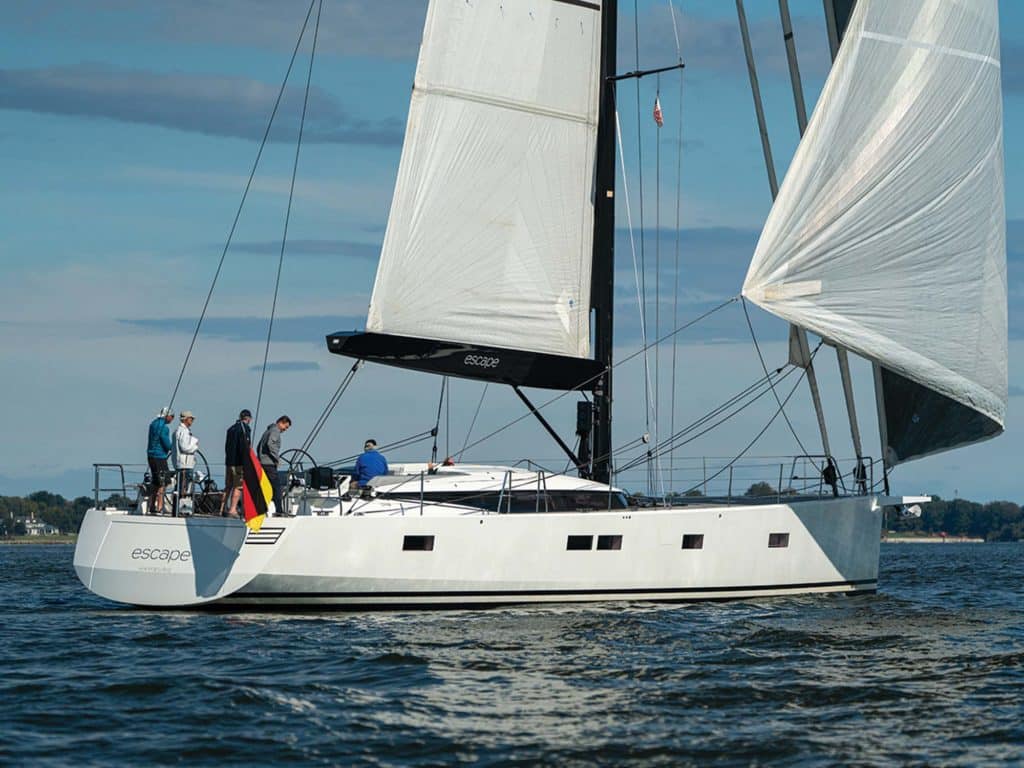
One year ago this month, as director of this magazine’s annual Boat of the Year contest, I joined our judging team aboard the CNB 66 Escape in Annapolis, Maryland, to conduct our sea trials on Chesapeake Bay. The high-end, long-range cruising boat was owned by a vastly experienced German couple named Karl and Annamarie Frank, who’d been based in Annapolis the past several years while rambling up and down the East Coast. Generally, our test sails involve yacht designers and manufacturers’ representatives. It was unusual, though not unprecedented, to go sailing with a couple on their own boat (our earlier dockside inspections occurred on a newer sistership model of the CNB 66). When it happens, though, it’s always interesting and enlightening.
Karl Frank was clearly one hell of a sailor who’d optimized the deck layout for singlehanded sailing; we all shared a joke about “German engineering.” He’d put a lot of thought into everything, and quickly got our attention and respect. (Annamarie told us that she didn’t care much for offshore sailing but loved the destinations, and opted out of passages when she could.) Later, in deliberations, judge Gerry Douglas said: “The build quality was just impeccable. The owner understood how to sail it well, and he had a system where he could handle it solo. He proved that you could operate a big, sophisticated boat alone.”
Here are a few excerpts about this ultra-sophisticated yacht from my own notes that day: “German couple on board their personal boat… Have laid it out beautifully… Running backstays with split fixed backstays adjusted belowdecks w/ hydraulic ram… Complicated… Carbon rig, in-boom furler… Huge Park Ave.-style boom….”
I hadn’t thought anything about Karl and Annamarie until late in July, when I learned that they both died in mid-June after a reefing maneuver gone very wrong in stormy conditions en route from Bermuda to Nova Scotia. Both had been airlifted from Escape by a US Coast Guard helicopter but succumbed to their wounds before ever reaching shore.
A lengthy report, first published by Blue Water Sailing magazine and later reprinted in the newsletter Scuttlebutt, recounted the entire horrible tale, as told to veteran cruising sailor Sheldon Stuchell by one of the two additional crew on board for the trip (I was surprised by this detail because Karl had been quite clear that he preferred sailing without outside assistance). In essence, it appeared that Annamarie, handling the mainsheet, lost control of that big boom, and both she and Karl subsequently got tangled in and clobbered by its flailing sheet.
So, if there even is one, what’s the moral of all this? Pretty simple. If it could happen to the Franks, it could happen to any of us.
Earlier this year, I took a sailing trip with a famous, world-class mountain climber. Late one night after a few belts, we got around to talking about the perils of our respective passions, and of our friends and acquaintances who’d perished pursuing them (see “The Sail to Nowhere,” September). As I started to mentally take inventory of the longish list of ocean sailors I personally knew who have been lost at sea, it occurred to me that offshore sailing isn’t quite as hazardous as high-altitude mountaineering adventures. But it’s a damn sight closer than most of us would ever care to admit.
A decade ago, as I’ve written before, I was part of a 28,000-nautical-mile expedition that sailed around North and South America via the Northwest Passage and Cape Horn. Before we shoved off, our core crew had a sobering conversation about what to do with our bodies if we didn’t make it back to shore. My answer was quick and straightforward: Commit me to the deep. I’ve got a few mates waiting for me.
And now Karl and Annamarie are waiting there too.
Herb McCormick is a CW editor-at-large.








